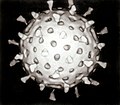| Type | Family | Transmission | Diseases | Treatment | Prevention |
|---|
| Adenovirus | Adenoviridae | - droplet contact [4]
- fecal-oral [4]
- venereal [4]
- direct eye contact [4]
| | None [4] | - Adenovirus vaccine
- hand washing
- covering mouth when coughing or sneezing
- avoiding close contact with the sick
|
| Coxsackievirus | Picornaviridae | | | None [4] | - hand washing
- covering mouth when coughing/sneezing
- avoiding contaminated food/water
- improved sanitation
|
| Cytomegalovirus | Herpesviridae | | | | - hand washing
- avoid sharing food and drinks with others
- safe sex
|
| Epstein–Barr virus | Herpesviridae | | | None [4] | - avoiding close contact with the sick
|
| Hepatitis A virus | Picornaviridae | | | Immunoglobulin (post-exposure prophylaxis) [4] | |
| Hepatitis B virus | Hepadnaviridae | Vertical and sexual [33] | | | |
| Hepatitis C virus | Flaviviridae | | | | - avoiding shared needles/syringes
- safe sex
|
| Herpes simplex virus, type 1 | Herpesviridae | | | | - avoiding close contact with lesions
- safe sex
|
| Herpes simplex virus, type 2 | Herpesviridae | | | | - avoiding close contact with lesions [4]
- safe sex [4]
|
| HIV | Retroviridae | | | HAART, [4] such as protease inhibitors [35] and reverse-transcriptase inhibitors [35] | - zidovudine (perinatally) [4]
- blood product screening [4]
- safe sex [4]
- avoiding shared needles/syringes
|
| Human coronavirus 229E (HCoV-229E) | Coronaviridae | | | | |
| Human coronavirus NL63 (HCoV-NL63) | Coronaviridae | | | | |
| Human coronavirus OC43 (HCoV-OC43) | Coronaviridae | | | | |
| Human coronavirus HKU1 (HCoV-HKU1) | Coronaviridae | | | | |
| Human herpesvirus, type 8 | Herpesviridae | | | many in evaluation-stage [4] | - avoid close contact with lesions
- safe sex
|
| Human papillomavirus | Papillomaviridae | | | | |
| Influenza virus | Orthomyxoviridae | | | | |
| Measles virus | Paramyxoviridae | | | None [4] | |
| Middle East respiratory syndrome-related coronavirus (MERS-CoV) | Coronaviridae | | | | |
| Mumps virus | Paramyxoviridae | | | None [4] | |
| Parainfluenza virus | Paramyxoviridae | | | None [4] | - hand washing
- covering mouth when coughing/sneezing
|
| Poliovirus | Picornaviridae | | | None [4] | |
| Rabies virus | Rhabdoviridae | | | Post-exposure prophylaxis [4] | |
| Respiratory syncytial virus | Pneumoviridae | | | (ribavirin) [4] | - hand washing [4]
- avoiding close contact with the sick [4]
- palivizumab in high risk individuals [4]
- covering mouth when coughing/sneezing
|
| Rubella virus | Togaviridae | - Respiratory [37] droplet contact [4]
| | None [4] | |
| Severe acute respiratory syndrome coronavirus (SARS-CoV) | Coronaviridae | | | | |
| Severe acute respiratory syndrome coronavirus 2 (SARS-CoV-2) | Coronaviridae | | | | |
| Varicella-zoster virus | Herpesviridae | - droplet contact [4]
- direct contact
| | Varicella: Zoster: | Varicella: Zoster: - vaccine
- varicella-zoster immunoglobulin
|


